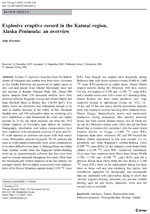Mageik Ferrocreted Ash
Start: 2400 yBP [1]
Event Type: Explosive
- Tephrafall [1]
- Phreatic [1]
Description: From Fierstein (2007): "In contrast with the East Mageik Summit crater, the ice free fumarolically active crater between the East and Central Mageik Summits has no juvenile ejecta and is not magmatic. This 250-m-wide phreatic crater (Fenner 1930; Hildreth and others 2000) contains an acid lake and many superheated fumarolic jets. The "ferrocreted layer" (described above in the "Mageik Creek section (K-2196): six pre-1912 tephras") is the youngest ejecta layer identified from Mount Mageik and most likely marks initiation or development of this phreatic vent between 2,400 and 2,500 14C years BP. This tephra layer directly overlies (and fills interstices on the surface of) the south lobes from East Mageik (see Fig. 15 [in original text])."
"The youngest preserved ejecta from Mount Mageik, 15 cm above the crystal-rich ash (just described), is informally called the "ferrocreted" layer, here 5 cm thick. As thick as 7 to 15 cm on the Mageik lava bench near Katmai Pass (section K-2547C), and ∼4 cm thick (but irregular to 13 cm) at the foot of Mount Griggs (section K-2244; Fig. 15 [in original text]), it is typically a slightly normally graded, poorly sorted, fine to coarse ash and granule tephra. At all locations most clasts are coated orange to rusty dark orange-red, the deposits include hydrothermally altered clasts, and in Katmai Pass and the Griggs Fork are ferrocreted to some degree. In Mageik Creek, 5 cm of the "soil" directly underlying the ash is red. Dense clasts to 0.5 cm are found in Mageik Creek (sample K-2199), but they are as big as 3 cm near Katmai Pass, including white- to-pink hydrothermally altered lava clasts and light grey, glassy, finely vesicular crystal-rich lava (plag+cpx±opx, no olivine). Stratigraphic correlations of other tephra layers in these sections from Mageik Creek to Katmai Pass to the Griggs Fork (Fig. 15 [in original text]) corroborates that these "ferrocreted deposits" are all at the same stratigraphic horizon and record a single phreatic episode. In Mageik Creek, the ferrocreted layer lies 15 cm beneath the mica-bearing ash (2,310+/-120 14C years B.P.) and 15 cm above the young Mageik tephra just described (K-2198; ∼2,500 14C year B.P.), suggesting that the phreatic event was ∼2,400 14C years B.P. Clast size, deposit thickness, and glassy plag+cpx± opx lava clasts point to Mount Mageik as the source. This is the youngest recognized ejecta layer from Mageik, and it seems most likely to record initiation of the still-steaming phreatic crater just west of the East Mageik summit vent (Photo of phreatic crater in Hildreth and others 2000, Fig. 5 [in original text])."
"The youngest preserved ejecta from Mount Mageik, 15 cm above the crystal-rich ash (just described), is informally called the "ferrocreted" layer, here 5 cm thick. As thick as 7 to 15 cm on the Mageik lava bench near Katmai Pass (section K-2547C), and ∼4 cm thick (but irregular to 13 cm) at the foot of Mount Griggs (section K-2244; Fig. 15 [in original text]), it is typically a slightly normally graded, poorly sorted, fine to coarse ash and granule tephra. At all locations most clasts are coated orange to rusty dark orange-red, the deposits include hydrothermally altered clasts, and in Katmai Pass and the Griggs Fork are ferrocreted to some degree. In Mageik Creek, 5 cm of the "soil" directly underlying the ash is red. Dense clasts to 0.5 cm are found in Mageik Creek (sample K-2199), but they are as big as 3 cm near Katmai Pass, including white- to-pink hydrothermally altered lava clasts and light grey, glassy, finely vesicular crystal-rich lava (plag+cpx±opx, no olivine). Stratigraphic correlations of other tephra layers in these sections from Mageik Creek to Katmai Pass to the Griggs Fork (Fig. 15 [in original text]) corroborates that these "ferrocreted deposits" are all at the same stratigraphic horizon and record a single phreatic episode. In Mageik Creek, the ferrocreted layer lies 15 cm beneath the mica-bearing ash (2,310+/-120 14C years B.P.) and 15 cm above the young Mageik tephra just described (K-2198; ∼2,500 14C year B.P.), suggesting that the phreatic event was ∼2,400 14C years B.P. Clast size, deposit thickness, and glassy plag+cpx± opx lava clasts point to Mount Mageik as the source. This is the youngest recognized ejecta layer from Mageik, and it seems most likely to record initiation of the still-steaming phreatic crater just west of the East Mageik summit vent (Photo of phreatic crater in Hildreth and others 2000, Fig. 5 [in original text])."
References Cited
[1] Explosive eruptive record in the Katmai region, Alaska Peninsula: an overview, 2007
Fierstein, Judy, 2007, Explosive eruptive record in the Katmai region, Alaska Peninsula: an overview: Bulletin of Volcanology, v. 69, n. 5, p. 469-509, doi:10.1007/s00445-006-0097-y.Complete Eruption References
Explosive eruptive record in the Katmai region, Alaska Peninsula: an overview, 2007
Fierstein, Judy, 2007, Explosive eruptive record in the Katmai region, Alaska Peninsula: an overview: Bulletin of Volcanology, v. 69, n. 5, p. 469-509, doi:10.1007/s00445-006-0097-y.
